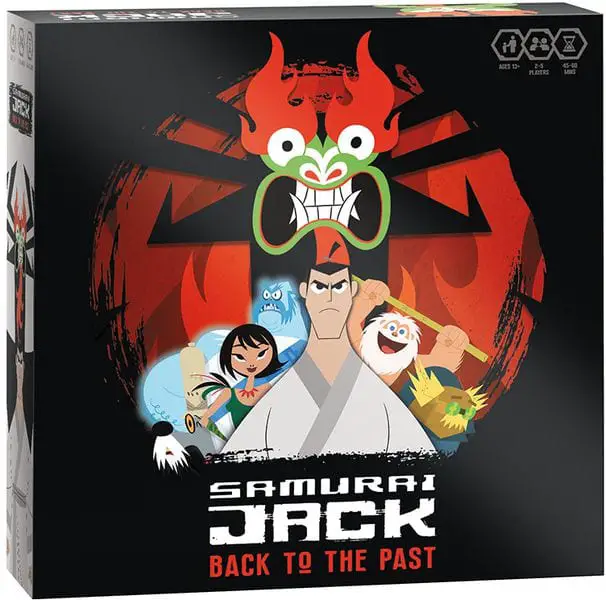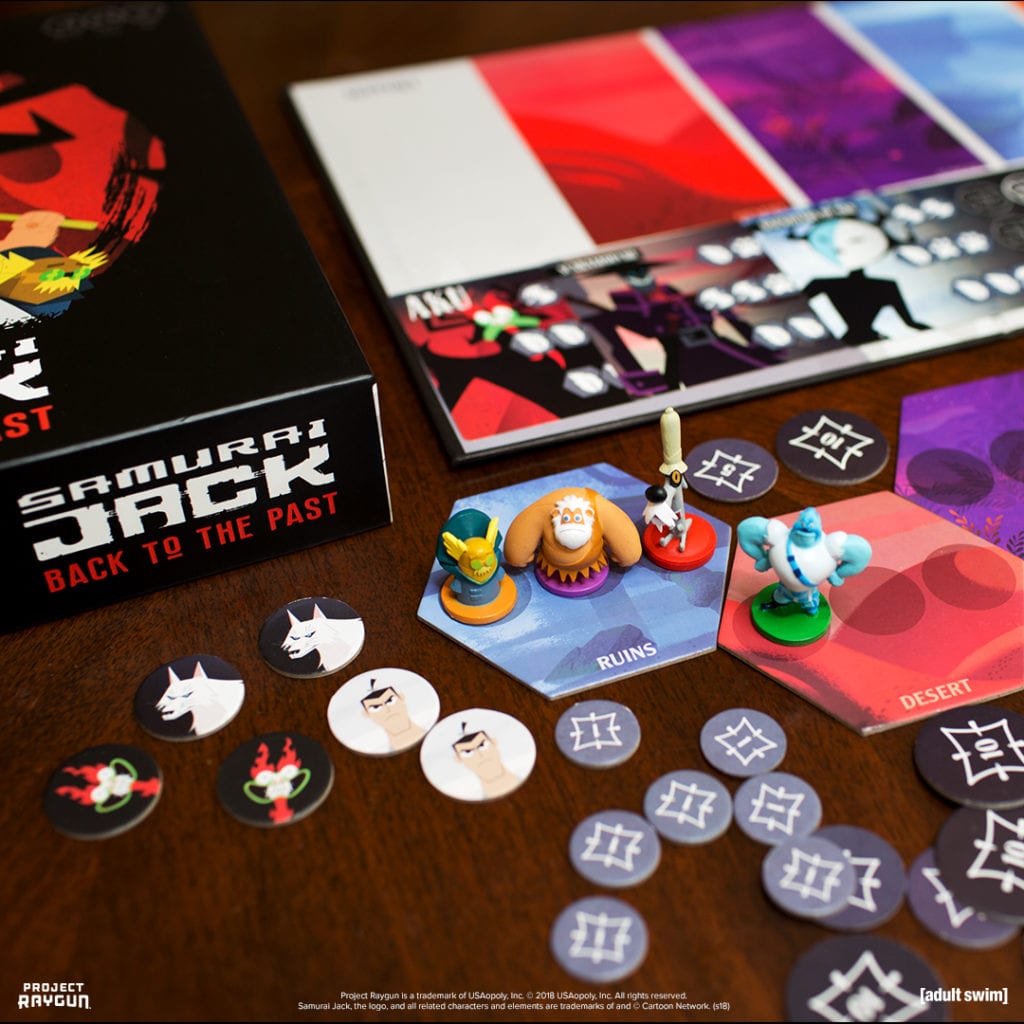I’ve been a fan of Samurai Jack since it debuted back in 2001 (when I may have admittedly been a bit young for it), and was extremely hyped when the new season came out. A game based on the series, especially one produced by a company well known for handling licensed games that don’t coast on their sources. One of my most anticipated games debuting at GenCon this year, Samurai Jack: Back to the Past is a “co-opetition” game from USAopoly set during the events of Samurai Jack’s fifth season. Taking on the role of one of Jack’s friends, both old and new, players must keep defeat Aku before Jack loses his sanity and all becomes lost.
Warning: Spoilers for Season 5 of Samurai Jack below
What’s In The Box?
The game itself is not huge, with most of the game consisting of cardboard hexagons, cards, and a few miniatures. However, the quality of the materials that make up the game is top notch. The art is all taken from the show itself, either direct scenes or using the stylistic background art that helps give the show its distinctive look. The box uses the bold lines and high contrast colors of the show to help it stand out in your collection (as well as a couple fun little appearances by Aku to peek out from between your games).

Inside the box, nearly every character shows up in one form or another, whether as an item, like the Scotsman’s Daughters, a villain to be defeated, like Scaramouche, or as one of the five playable characters. Funnily enough, you don’t get to play as Jack himself. Instead, you act as one of his allies: the canine archaeologist Rothchild, the acrobatic and feral Monkey Man, Ashi the daughter of Aku, the ghost of The Scotsman, and robo-mayor Max. They, and Jack and Aku, are all represented by the standout part of this game: the full color minis used as game pieces.
I’m not exaggerating when I say these are collector quality pieces. Substantial, colorful, and beautifully painted, they add that extra level of craftsmanship to the game we’ve come to expect from USAopoly. You’ll be hard pressed to keep these things in the box and not on the shelf when not in use.

How’s It Played?
The gameplay is centered around defeating Aku (what else could it be?). The goal of the players is to traverse through different areas collecting helpful items to defeat the boss at the end of the path. Player’s play movement cards to move themselves, Jack, and Aku along the path, and gather support cards to help them earn honor and defeat the villain at the end of the line. After defeating two of Aku’s henchmen, you battle the Master of All Evil himself. The game ends when Jack goes crazy or the evil is defeated, and the winner is the one with the most honor points. Seems simple enough, right?
Nothing is ever simple when Aku is involved. In a sense, Jack operates as an NPC for the game, which is something that you don’t see frequently in a board game like this. Jack is sort of like the prince in Masque of the Red Death in that players will want to be in the same space as he is at all times. If you’re in the same space as Jack, you gain one honor, get a special card draw, and Jack becomes a little more sane. But if he’s left alone, or he ends up sharing a space with Aku, he’ll go a little more cuckoo. When he’s at full crazy, he’ll succumb to his inner demons and the game will be over.
Aku is the other “NPC” of the game, operating independently, like Jack, but doing his best to muck things up for the players. Not only does he make Jack more insane, he also flings players with whom he shares a space into a portal, negating their move and sending their plans into disarray. Finally, should he reach the end before players, he will occupy a space on the villain board players would normally buy. And he always goes for the cheapest option. As he torments you more and more, you can almost hear his high, shrieking laughter in your ears.

The other thing limiting your chances of survival is good old fashioned competition. Just because you all want to help Jack doesn’t mean you want to help each other. While not allowing you to be as vindictive as, say, Munchkin, there’s still plenty of opportunity to screw over your fellow heroes by taking up limited space on each area, stealing the cards that help them best, or even maneuvering them straight into the path of Aku.
One of the most unique parts of the game is the board itself. While there’s a static board that acts as a “pool” for support cards and Jack/Aku movement cards, the game board changes each round. The ground literally shifts beneath your feet from turn to turn. After each villain is defeated, the fifteen interlocking hexagons that make up the board are shuffled and laid out again at random. The support cards are gained based on their placement on the static board, and you must use all of your movement cards before you can use any again (assuming you don’t retrieve them early by playing your hero’s home area). While there’s only so many variations to be made, the fact that it does change not only gives you a feel for the chaotic world of Aku, but also gives Back to the Past an incredibly high ceiling of replayability.
The only real issues with the game come at the very beginning and at the very end. The first is mainly a nitpick but, damn, the manual is NOT easy to read. Folded like a map rather than bound like a booklet, it can be hard tracing where the different rules are. While it does follow the path of the game step by step, things like how Jack works, how Aku works, honor, etc, aren’t explained in a well-clustered way. There were several times I found myself having to check the rules over and over because we had no idea what was and wasn’t legal.
The second issue is a little more impactful and that’s the ability to snowball in the game. Thanks to Aku and the leapfrog mechanic of movement where you go to the next available terrain if the first one is occupied, it’s easy to find yourself near the end of the path with little to show for it. And if you don’t have the support cards to beat the villain? You just go off to the side with Jack to watch, missing out on a share of the honor points gained from not helping defeat the villain.
Miss one of these but collect enough support cards and you might be able to make it. But if you get shut out of a round, or only get one or two, you will be in pretty bad shape when it gets to the end of the game. The “Encounter” cards help balance a little, but a savvy player could still easily mess up another’s chances fairly early with just a couple moves.
The Verdict

USAopoly puts a lot of love and polish into their games, and Samurai Jack: Back to the Past is no exception. It’s much like the season from which it takes inspiration: a well crafted love letter for fans, with lots of references and in-jokes throughout. Unlike some licensed games, I think Back to the Past only works best when played by people who have actually seen season five of Samurai Jack, or at least have seen the original run. The sometimes confusing rules and snowballing can turn a more casual player off if the property isn’t there to keep the enjoyment flowing. However, this is MUST HAVE for any fans of the show who want a fun, affordable game that captures the spirit of Tartakovsky’s masterpiece and comes in a beautifully rendered package.
![]()
![]()
![]()
Samurai Jack: Back To The Past is available nationwide at your local game shops (something USAopoly encourages you to support) as well as on Amazon. It retails for $34.99.
Be sure to keep an eye out on the Fandomentals for more reviews and coverage of USAopoly and all the games from your favorite properties!

